ACT Math For Dummies (2011)
Part IV. Visualizing Plane Geometry and Trigonometry
Chapter 12. Practice Problems for Geometry, Trig, and Advanced Math
Are you interested in practicing some geometry and trigonometry questions from the material in Chapters 10 and 11? Well, look no further. In this chapter, I include 30 problems with completely worked-out answers at the end of the chapter. Get your pencil ready!
Geometry, Trig, and Advanced Math Practice Problems
1. In the following figure, the two horizontal lines are parallel, and a° = 2b°. Which of the following answer choices is true?
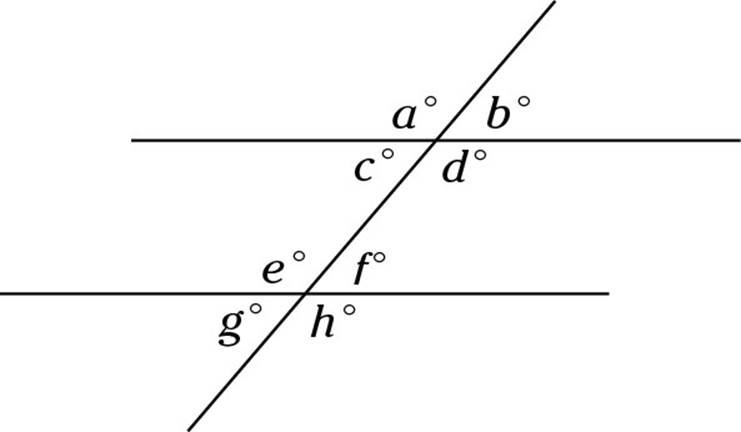
(A) a + d = 200
(B) a + f = 200
(C) a + e = 240
(D) b + g = 180
(E) b + h = 120
2. In the following figure, if the area of ΔTUV is 34, what is the area of ΔTUW?
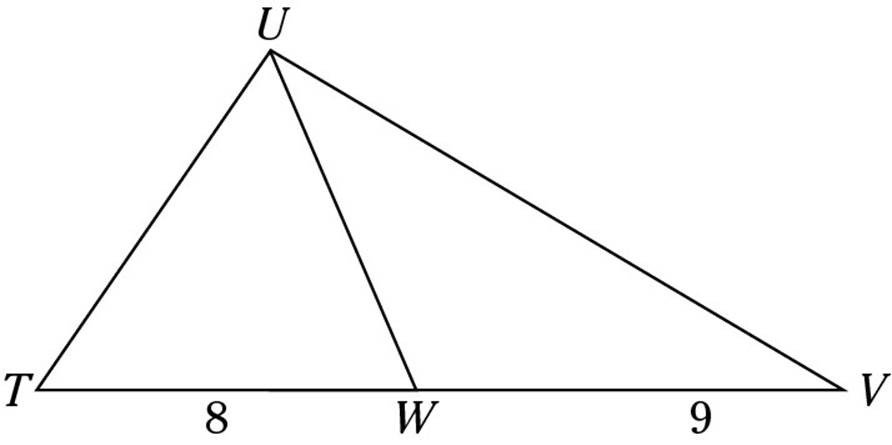
(F) 8
(G) 12
(H) 16
(J) 18
(K) 32
3. In the following figure, a circle with an area of 11π is embedded in a square. What is the perimeter of the square?
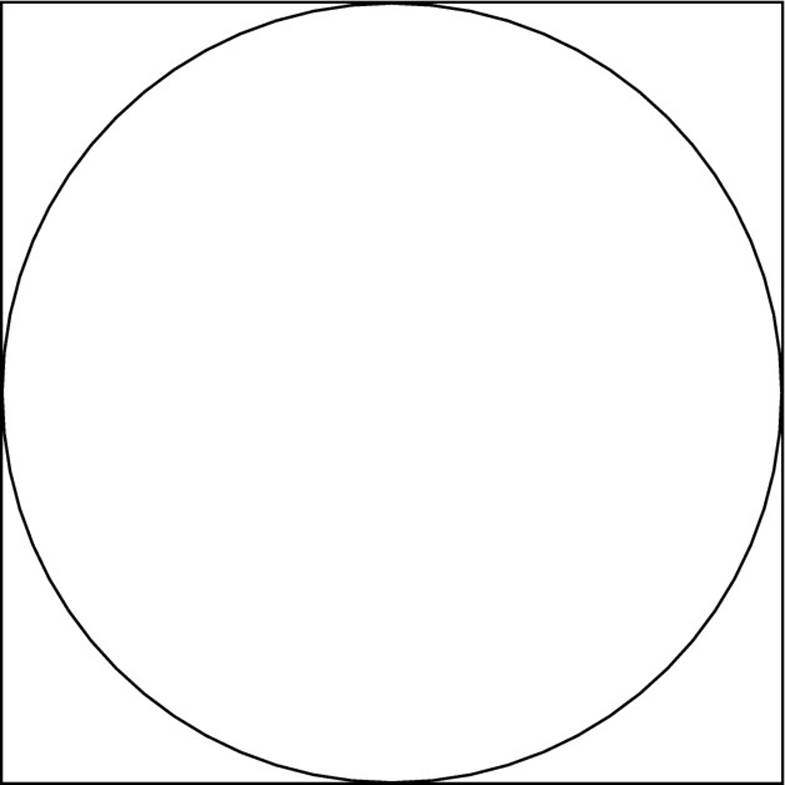
(A) 44
(B) 88
(C) ![]()
(D) ![]()
(E) ![]()
4. What is the value of tan x in the following figure?
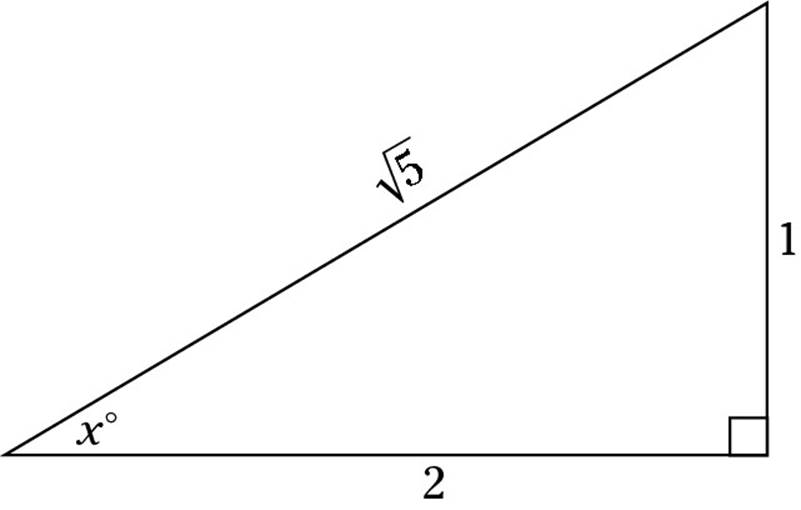
(F) 1
(G) 2
(H) ![]()
(J) ![]()
(K) ![]()
5. What is the area of the trapezoid in the following figure?
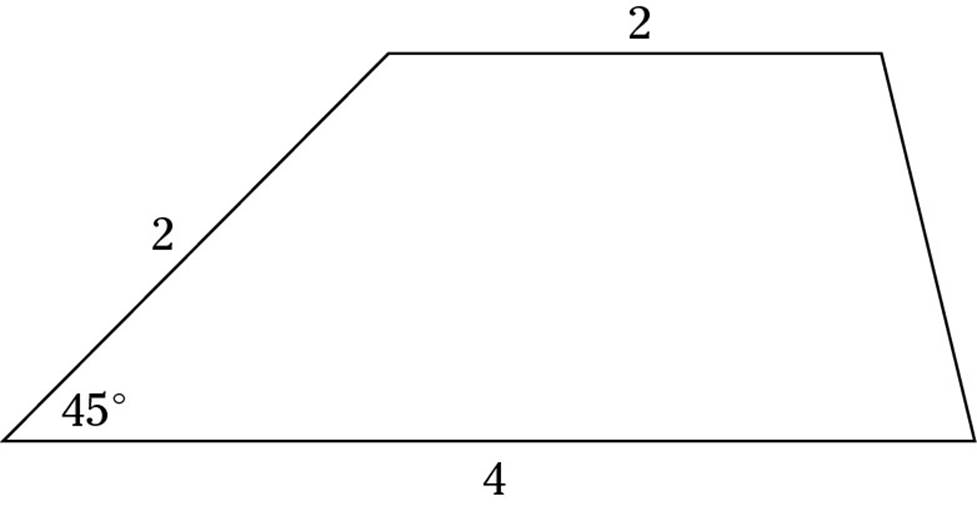
(A) 3
(B) 4
(C) 8
(D) ![]()
(E) ![]()
6. Heidi rides her bicycle to school and to her job at the mall. Her school is located exactly 4 miles due north of the mall and exactly 6 miles due east of her house. To the nearest whole mile, what is the shortest direct distance from Heidi’s house to the mall?
(F) 6 miles
(G) 7 miles
(H) 8 miles
(J) 9 miles
(K) 10 miles
7. What is the result when the sum of the matrices ![]() and
and ![]() is multiplied by 4?
is multiplied by 4?
(A) 24
(B) ![]()
(C) ![]()
(D) ![]()
(E) ![]()
8. The four interior angles in a quadrilateral measure 70°, f°, 4f°, and (2f – 25)°. What is the value of f?
(F) 25
(G) 35
(H) 40
(J) 45
(K) 50
9. A room has a square floor whose area is 625 square feet. If the volume of the entire room is 7,500 cubic feet, what is the difference between the length of one side of the room and the height of the room?
(A) 10 feet
(B) 11 feet
(C) 12 feet
(D) 13 feet
(E) 14 feet
10. In the following triangle, what is the value of cos b?
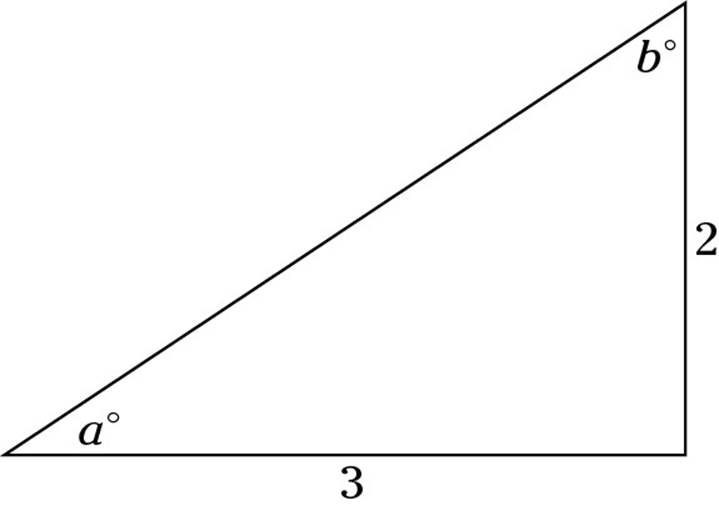
(F) ![]()
(G) ![]()
(H) ![]()
(J) ![]()
(K) ![]()
11. If the area of the parallelogram in the following figure is A, which of the answer choices is true?
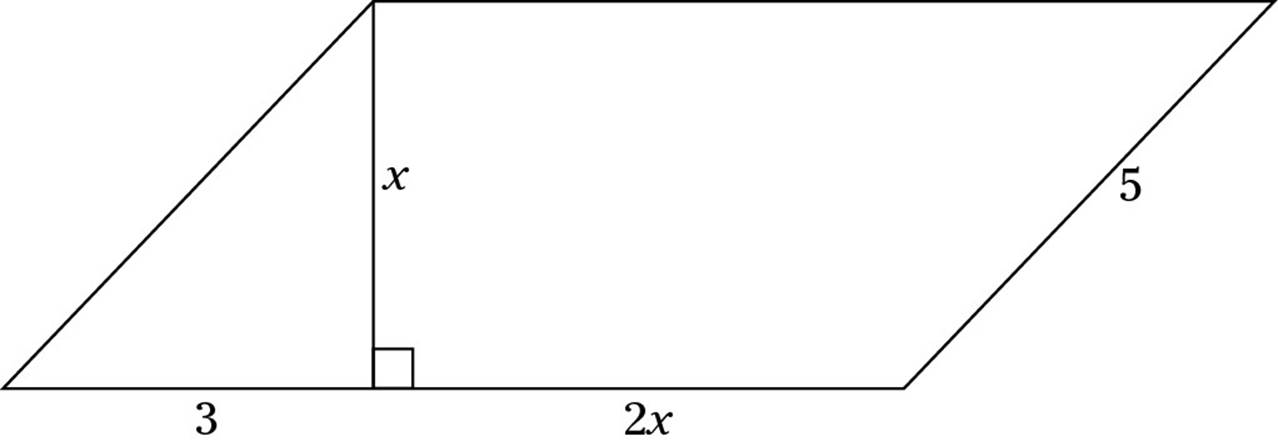
(A) 0 < A < 20
(B) 10 < A < 30
(C) 20 < A < 40
(D) 30 < A < 40
(E) 40 < A < 50
12. A circular fountain with a circumference of 24 feet is surrounded by a 3-foot-wide cement walkway. What is the total distance in feet around the outer edge of this walkway?
(F) 27
(G) 30
(H) 12 + 3π
(J) 24 + 3π
(K) 24 + 6π
13. What is the value of v2 if log3 v = 2?
(A) 3
(B) 8
(C) 9
(D) 64
(E) 81
14. What is the length of a 40° arc of a circle with a diameter of 18?
(F) π
(G) 2π
(H) 3π
(J) 9π
(K) 10π
15. In the following figure, what is the value of x?
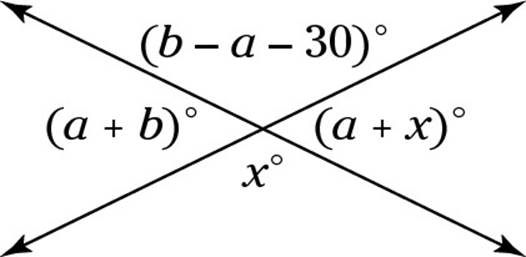
(A) 60
(B) 75
(C) 90
(D) 100
(E) 105
16. The formula for the surface area (A) of a sphere with a radius (r) is A = 4πr2. What is the circumference of a circle that has the same radius as a sphere with a surface area of 20 square meters?
(F) ![]()
(G) ![]()
(H) ![]()
(J) ![]()
(K) ![]()
17. If ![]() and
and ![]() , what is the value of
, what is the value of ![]() ?
?
(A) ![]()
(B) ![]()
(C) ![]()
(D) ![]()
(E) Cannot be determined from the information given.
18. What is the area of an isosceles triangle with two sides of length 13 and one side of length 10?
(F) 60
(G) 65
(H) 100
(J) 120
(K) 130
19. If i2 = –1, what is the result when you multiply (1 – i) by (3 + 2i)?
(A) 2 + i
(B) 3 + i
(C) 3 – i
(D) 4 + i
(E) 5 – i
20. In the following figure, what is the area of the parallelogram?
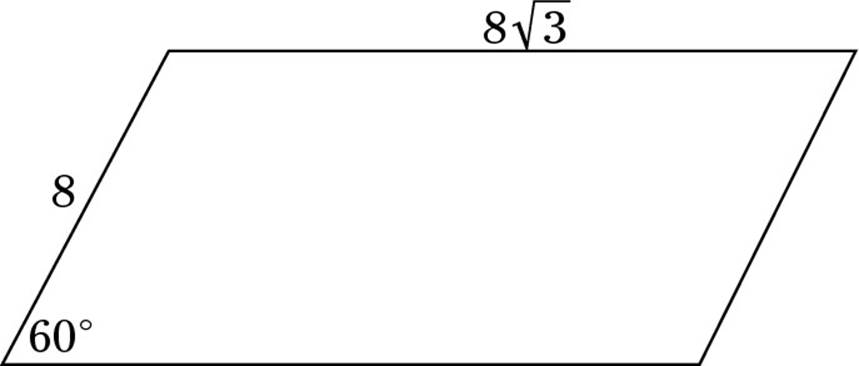
(F) 48
(G) 96
(H) ![]()
(J) ![]()
(K) ![]()
21. If an angle measures ![]() radians, what is its measurement in degrees?
radians, what is its measurement in degrees?
(A) 67.5°
(B) 72°
(C) 135°
(D) 144°
(E) 288°
22. In the following figure, ![]() is tangent to the circle and has a length of 15. If the circle has an area of 64π, what is the length of
is tangent to the circle and has a length of 15. If the circle has an area of 64π, what is the length of ![]() ?
?
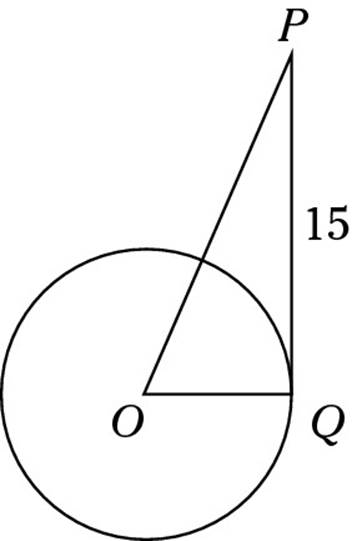
(F) 16
(G) 17
(H) 18
(J) 19
(K) 20
23. In the following figure, p° =
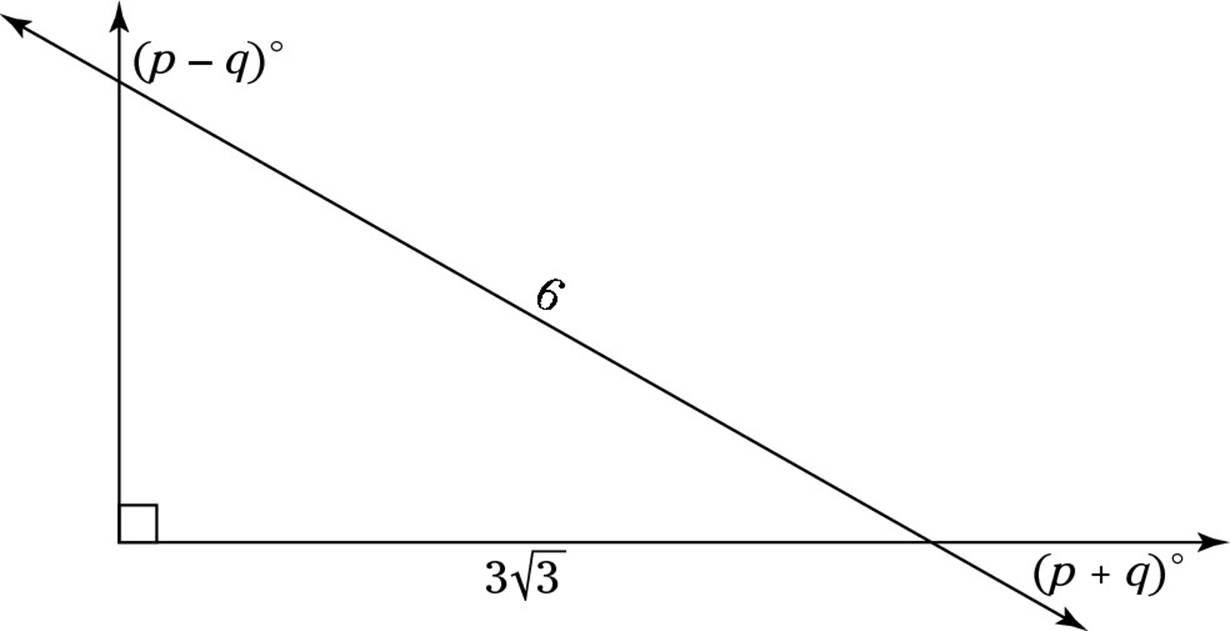
(A) 45°
(B) 55°
(C) 65°
(D) 75°
(E) 80°
24. If A = ![]() and B =
and B = ![]() , what is the result of the matrix multiplication A × B?
, what is the result of the matrix multiplication A × B?
(F) 22
(G) ![]()
(H) ![]()
(J) ![]()
(K) ![]()
25. In the following figure, the circle is circumscribed about the square. If the perimeter of the square is 12, what is the circumference of the circle?
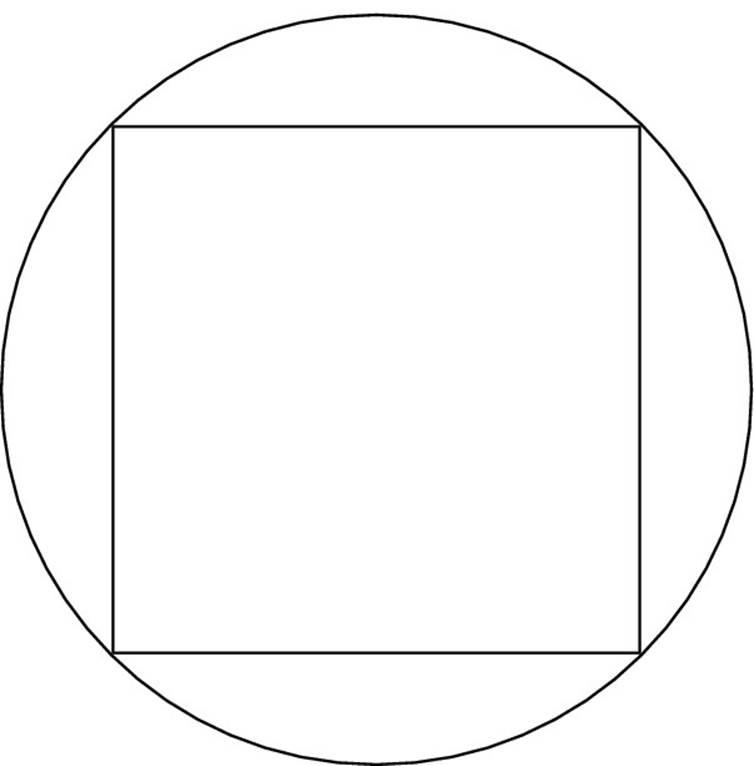
(A) ![]()
(B) ![]()
(C) ![]()
(D) ![]()
(E) ![]()
26. A sphere and a cylinder both have the same volume (V) and the same radius (r). What is the height of the cylinder in terms of r?
(F) 4r
(G) ![]()
(H) ![]()
(J) ![]()
(K) ![]()
27. In the following graph, a is the amplitude of the wave, and p is its period. Which of the following is true?
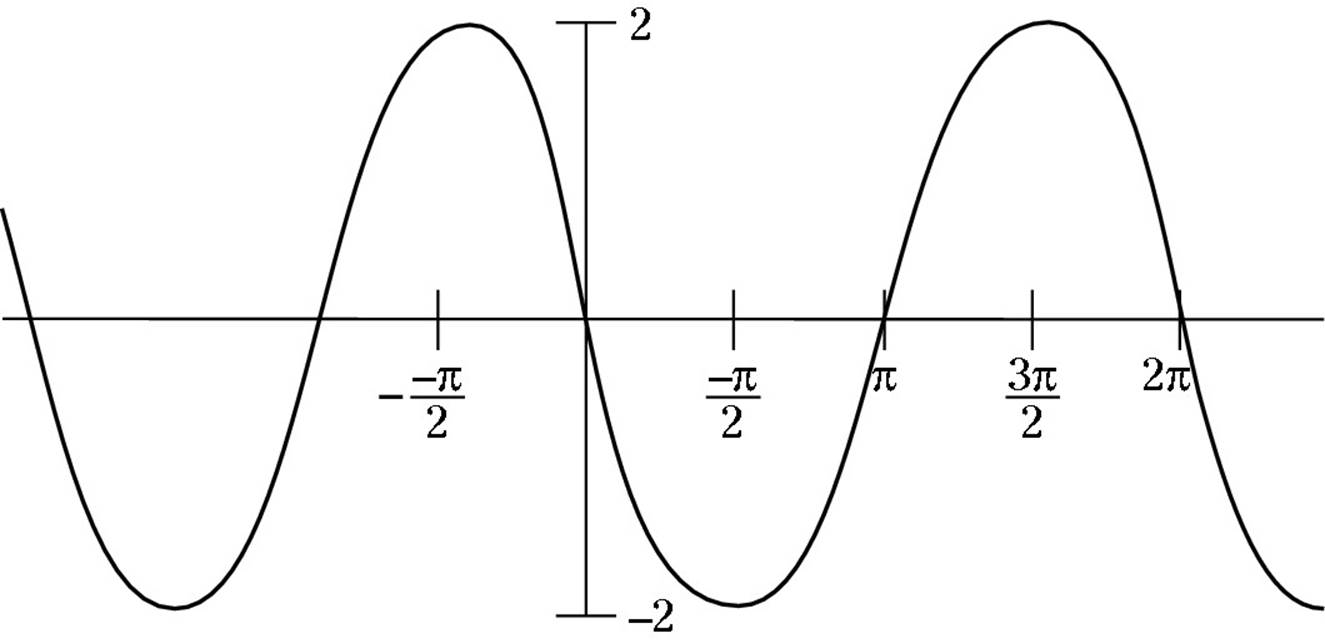
(A) ![]()
(B) ![]()
(C) ![]()
(D) ![]()
(E) ![]()
28. If loga b = 2 and a2 = 100, what is the value of b2?
(F) ![]()
(G) 10
(H) 100
(J) 1,000
(K) 10,000
29. In the complex numbers, where i2 = –1, what is the result when you multiply ![]() by
by ![]() ?
?
(A) ![]()
(B) ![]()
(C) ![]()
(D) ![]()
(E) ![]()
30. In the following figure, the six points A through F are spaced equidistantly around a circle with a radius of 10. The intersection of ΔACE and ΔBDF is shaded. What is the area of this shaded region?
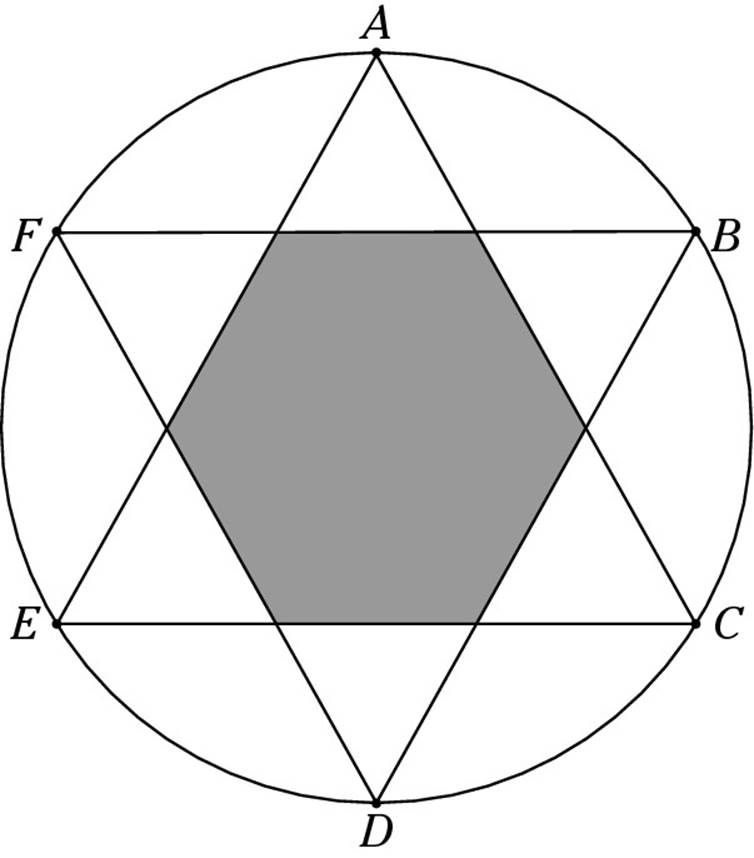
(F) ![]()
(G) ![]()
(H) ![]()
(J) ![]()
(K) ![]()
Solutions to Geometry, Trig, and Advanced Math Practice Problems
Here are the answers to the practice questions from the preceding section, complete with worked-out solutions.
1. C. The angles a° and b° are supplementary, so you can make the following equation:
a + b = 180
The question tells you that a° = 2b°, so substitute 2b for a in the preceding equation, and solve for b:
2b + b = 180
3b = 180
b = 60
Thus, the value of c, f, and g is also 60, and the value of a, d, e, and h is 120. So
a + e = 120 + 120
a + e = 240
2. H. The area of ΔTUV is 34 and the base is 8 + 9 = 17, so you can use the area formula for a triangle to find the height:

The height of ΔTUV is also the height of ΔTUW, and the base of ΔTUW is 8, so
![]()
3. E. The circle has an area of 11π, so use the area formula for a circle to find the radius:
![]()
The diameter of the circle is twice the radius, so it’s ![]() . This value is also the length of the side of the square, so use the perimeter formula for a square to get your answer:
. This value is also the length of the side of the square, so use the perimeter formula for a square to get your answer:
![]()
4. J. Recall that the tangent of an angle is the ratio of the opposite side over the adjacent side. So
![]()
The opposite side is 1 and the adjacent side is 2, so plug these numbers in the preceding formula to get your answer:
![]()
5. D. To calculate the area of the trapezoid, you need to know the height. To find it, draw a line in the original figure, like this:
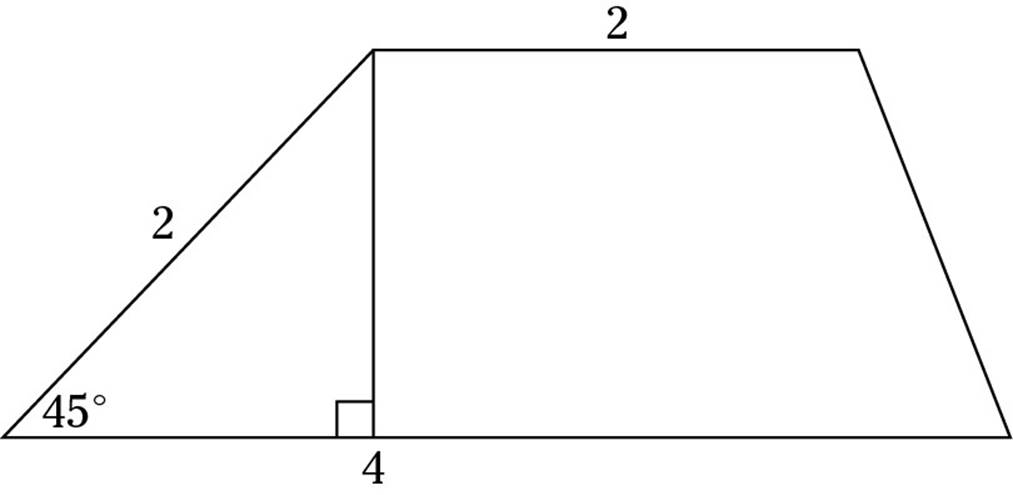
Note that the triangle is a 45-45-90 triangle with a hypotenuse of 2. The vertical leg of this triangle is also the height of the trapezoid. Recall that the hypotenuse of a 45-45-90 triangle is ![]() times the leg. So calculate the length of a leg (x) as follows:
times the leg. So calculate the length of a leg (x) as follows:
![]()
You can simplify this value, as I show you in Chapter 4, like this:
![]()
Thus, the length of each leg is ![]() . This is the height of the trapezoid, so plug this value into the formula for the area of a trapezoid, along with the lengths of the two bases, to find the answer:
. This is the height of the trapezoid, so plug this value into the formula for the area of a trapezoid, along with the lengths of the two bases, to find the answer:
![]()
6. G. Begin by drawing a picture showing where Heidi’s house, her school, and the mall are located:
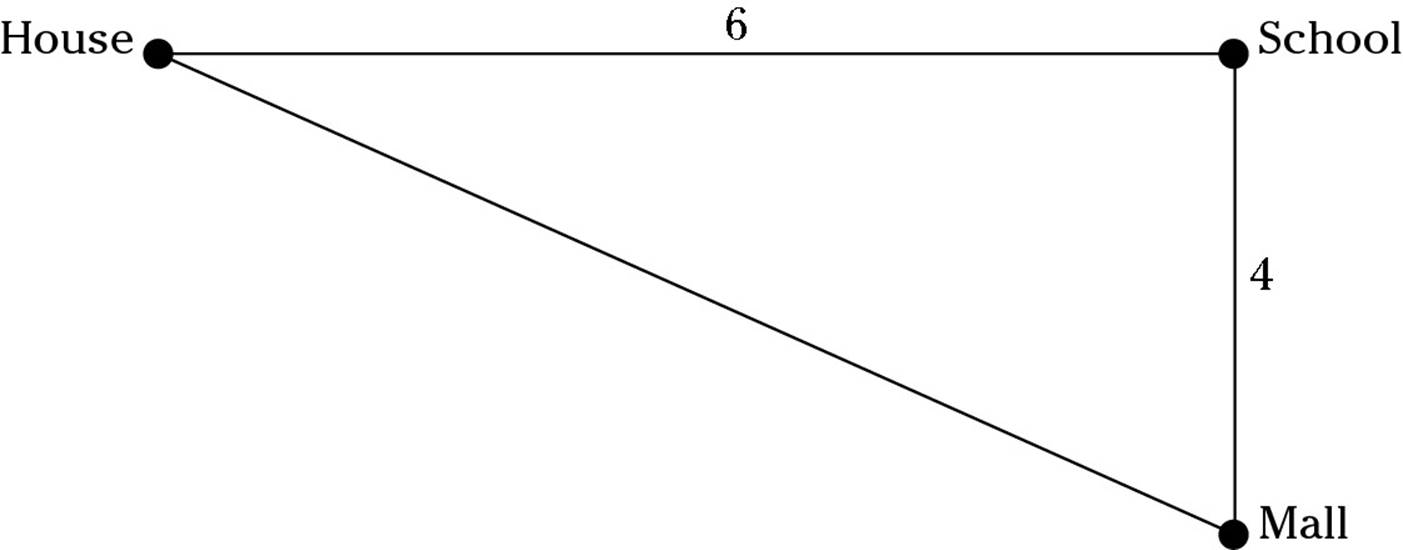
The three locations form a right triangle, so use the Pythagorean theorem (a2 + b2 = c2) to find the distance from the house to the mall:

7. E. First, use matrix addition to find the sum of the two matrices:
![]() +
+ ![]() =
= ![]()
Now multiply the result by 4:
![]() =
= ![]()
8. J. The measures of the four interior angles in a quadrilateral add up to 360°, so you can make the following equation:
70 + f + 4f + (2f – 25) = 360
Solve for f:
70 + f + 4f + 2f – 25 = 360
45 + 7f = 360
7f = 315
f = 45
9. D. The room has a square floor that has an area of 625 square feet, so calculate the length of one side of the room like this:
A = s2
625 = s2
25 = s
The volume of the room is 7,500 cubic feet, so find the height of the room using the formula for the volume of a box:
V = lwh
7,500 = (25)(25)h
12 = h
So the difference between the length of one side and the height of the room is 25 – 12 = 13.
10. J. The figure shows a triangle with sides that are of lengths 2 and 3, so use the Pythagorean theorem to find the length of the hypotenuse:
![]()
The cosine of b is the ratio of the adjacent side (2) over the hypotenuse (![]() ), so
), so
![]()
To remove the radical from the denominator to get the correct answer, multiply both the numerator and the denominator by ![]() :
:
![]()
11. E. The figure is a parallelogram, meaning the opposite sides are equal. So each of the two slanted sides has a length of 5. Thus, the triangle in the figure is a right triangle with one leg the length of 3 and the hypotenuse the length of 5. Using the Pythagorean theorem, you can find that x = 4. So the height of the parallelogram is 4, and the base is:
3 + 2x = 3 + 2(4) = 3 + 8 = 11
Use these values to calculate the area of the parallelogram:
A = bh = (11)(4) = 44
12. K. The circumference of the fountain is 24 feet, so use the formula for the circumference of a circle to find the radius:
![]()
The width of the walkway is 3 feet, so the radius of the outer edge of it is ![]() , which equals
, which equals ![]() . Use this radius to find the circumference of the outer edge:
. Use this radius to find the circumference of the outer edge:
![]()
13. E. Change the logarithm to a power:
log3 v = 2 means 32 = v
Because v = 9, you know that v2 = 92 = 81.
14. G. To solve this problem, use the arc length formula, plugging in 40° and a radius of 9:
![]()
15. E. The two angles (a + b)° and (b – a – 30)° are supplementary angles, so you can put together this equation:
a + b + b – a – 30 = 180
Now simplify and solve for b:
2b – 30 = 180
2b = 210
b = 105
The two angles (a + b)° and (a + x)° are vertical angles, so
a + b = a + x
b = x
Thus, x = 105.
16. K. Use the formula for the surface area of a sphere to find the radius of a sphere with a surface area of 20:
![]()
Plug this value into the formula for the circumference of a circle:
![]()
You now can simplify this answer by recognizing that ![]() :
:
![]()
17. A. The problem tells you that ![]() , so use a trig identity to find
, so use a trig identity to find ![]() :
:
![]()
The problem also tells you that ![]() , so use a trig identity to find
, so use a trig identity to find ![]() :
:
![]()
18. F. You need to find the height in order to calculate the area, so draw in the height and split the base as follows:
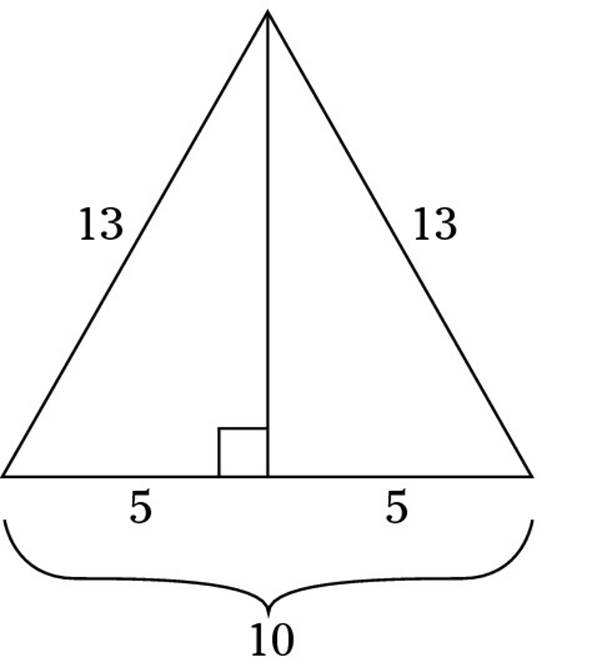
You can use the Pythagorean theorem to calculate the height, but you can save time by noticing that the triangle splits into two 5-12-13 triangles. So you know its height is 12. Thus, calculate its area using the formula for a triangle:
![]()
19. E. Begin by FOILing the two complex numbers:
(1 – i)(3 + 2i) = 3 + 2i – 3i – 2i2
Next, combine like terms:
= 3 – i – 2i2
As you know from the problem, i2 = –1, so you can plug in that value:
= 3 – i – 2(–1)
= 3 – i + 2
= 5 – i
20. G. To begin, add an extra line to the figure, as follows:
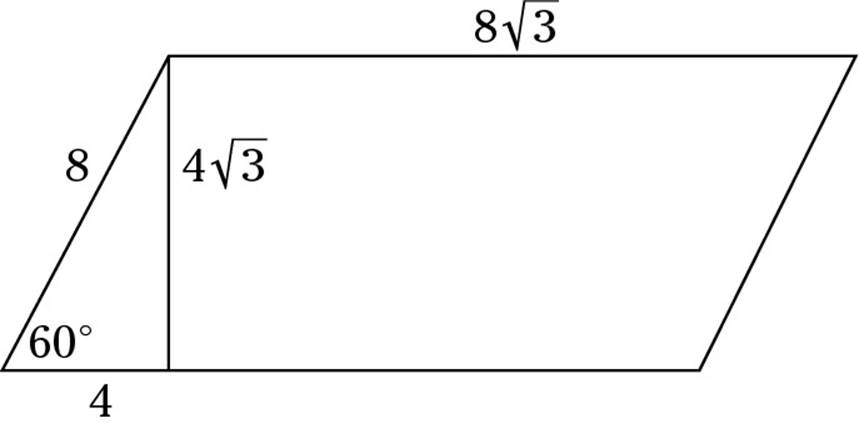
Notice that the resulting 30-60-90 triangle has a hypotenuse of 8, so it has legs with the lengths of 4 and ![]() . So the height of the parallelogram is
. So the height of the parallelogram is ![]() and its base is
and its base is ![]() . Plug these values into the formula for the area of a parallelogram:
. Plug these values into the formula for the area of a parallelogram:
![]()
21. D. Use the formula for converting radians to degrees:
![]()
Substitute ![]() for radians and let d = degrees:
for radians and let d = degrees:
![]()
To solve for d, begin by cross-multiplying. I suggest you do this in two steps:
![]()
Simplify and solve:
![]()
22. G. The area of the circle is 64π, so use the formula for the area of a circle to find the radius:
![]()
Thus, ![]() .
. ![]() is tangent to the circle, so
is tangent to the circle, so ![]() . Thus, ΔPQO is a right triangle. Use the Pythagorean theorem:
. Thus, ΔPQO is a right triangle. Use the Pythagorean theorem:

Thus, ![]() .
.
23. D. The long side of the triangle is ![]() and the hypotenuse is 6, so it’s a 30-60-90 triangle as you see here:
and the hypotenuse is 6, so it’s a 30-60-90 triangle as you see here:
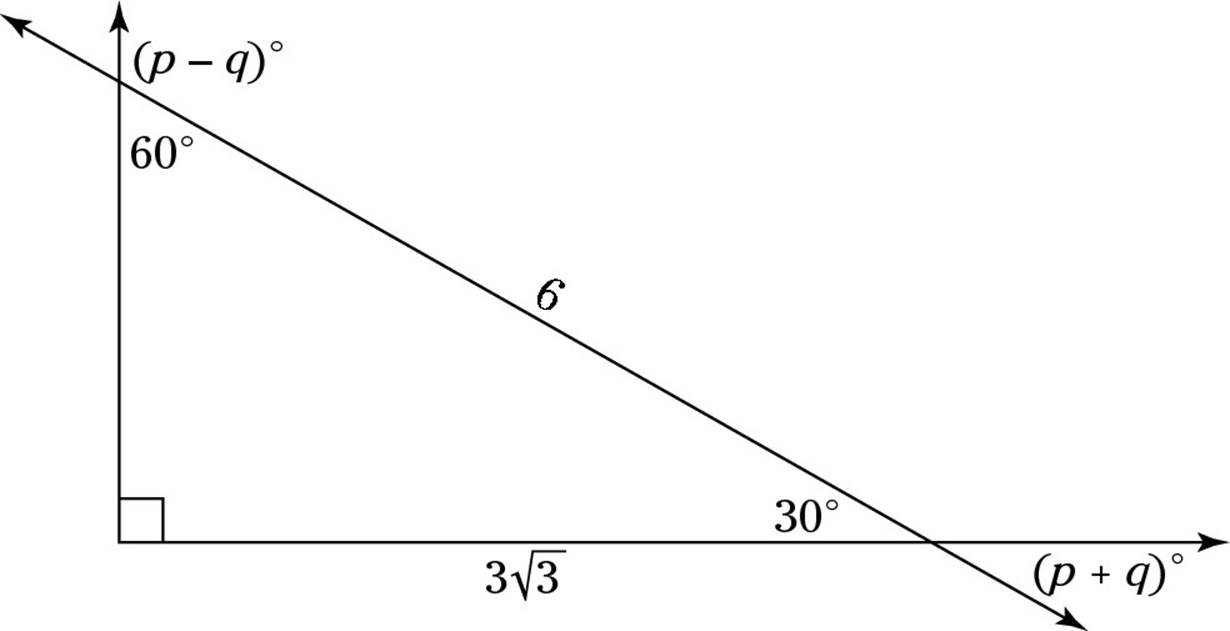
Because 30° and (p + q)° are vertical angles, you can create this equation:
p + q = 30
Additionally, 60° and (p – q)° are supplementary angles, so
p – q + 60 = 180
p – q = 120
Now you can add these two equations:

Solve for p:
p = 75
24. J. Make a chart using the two matrices in the order given in the multiplication:
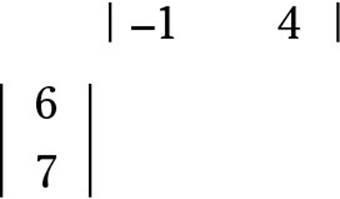
Fill in the chart:
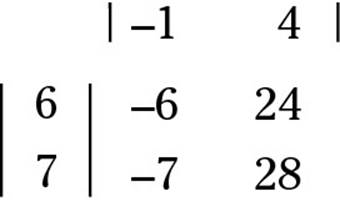
To get your answer, form a matrix according to the results in the chart:
![]()
25. E. The perimeter of the square is 12, so each side of the square is 3. Thus, the diagonal from one corner of the square to the other is ![]() . This is also the diameter of the circle, so the radius of the circle is half of this, which is
. This is also the diameter of the circle, so the radius of the circle is half of this, which is ![]() . Plug this value into the formula for the circumference of a circle:
. Plug this value into the formula for the circumference of a circle:
![]()
26. H. The formula for the volume of a sphere is ![]() , and the formula for the volume of a cylinder is
, and the formula for the volume of a cylinder is ![]() . The volumes of the sphere and cylinder are equal, as are the radii of each solid, so you can set the two right sides of the equations equal:
. The volumes of the sphere and cylinder are equal, as are the radii of each solid, so you can set the two right sides of the equations equal:
![]()
Solve for h in terms of r:
![]()
27. B. The amplitude is the distance from the vertical middle of the graph to the crest, so a = 2. The period is the distance between two adjacent crests, so p = 2π. With this information, you can see that the correct answer is Choice (B).
28. K. Change the logarithm to a power:
loga b = 2 means a2 = b
The question tells you that a2 = 100, so b = 100. Therefore
b2 = 1002 = 10,000
29. E. Multiply the two fractions using the usual rules for multiplication:
![]()
FOIL the denominator and simplify:
![]()
Substitute –1 for i2 and solve:
![]()
30. G. To solve this problem, first find the length of the side of either of the large triangles. Note that both triangles are equilateral, so their angles measure 60° each. To find the length of one side, notice that the radius of the circle forms a 30-60-90 triangle as shown here:
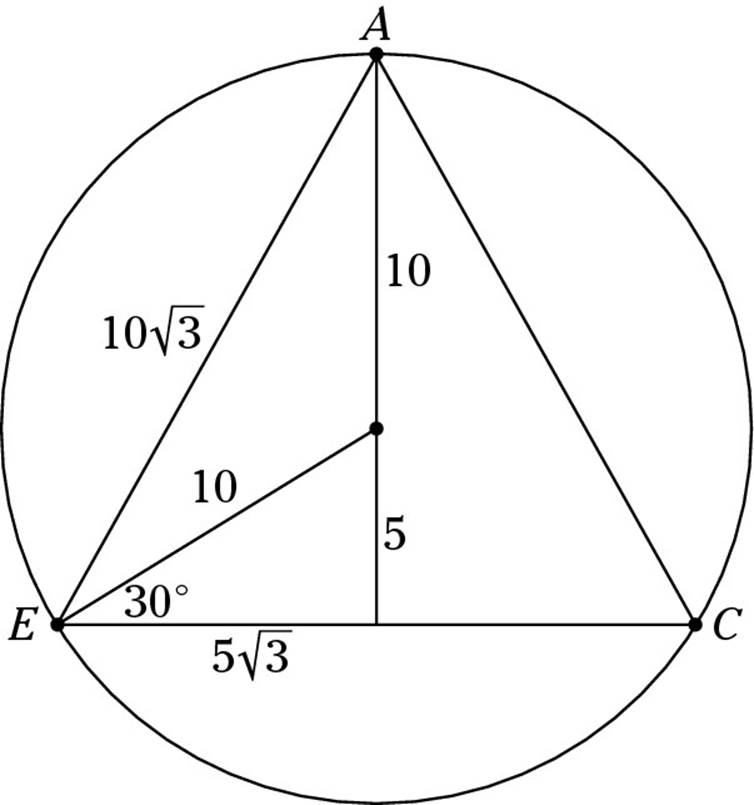
Thus, the length of the side of the triangle is ![]() , and its height is 15. Plug these values into the formula for the area of a triangle:
, and its height is 15. Plug these values into the formula for the area of a triangle:
![]()
Next, notice that each triangle separates into 9 small, equal-sized triangles:
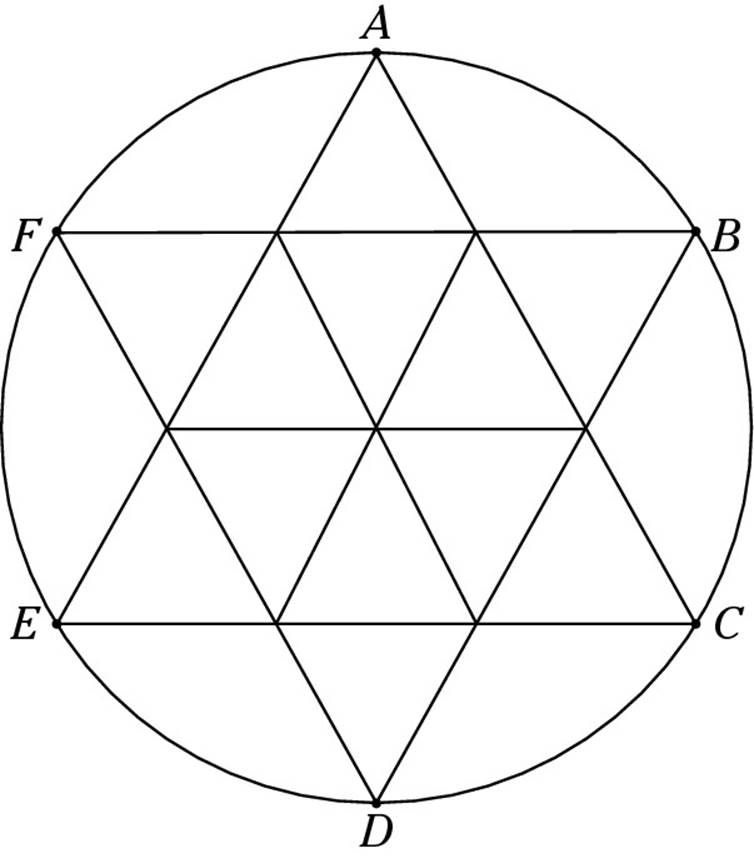
Each of these triangles has an area of ![]() the area of the larger triangle. So
the area of the larger triangle. So
![]()
The shaded area is composed of 6 of these small triangles, so its area is
![]()